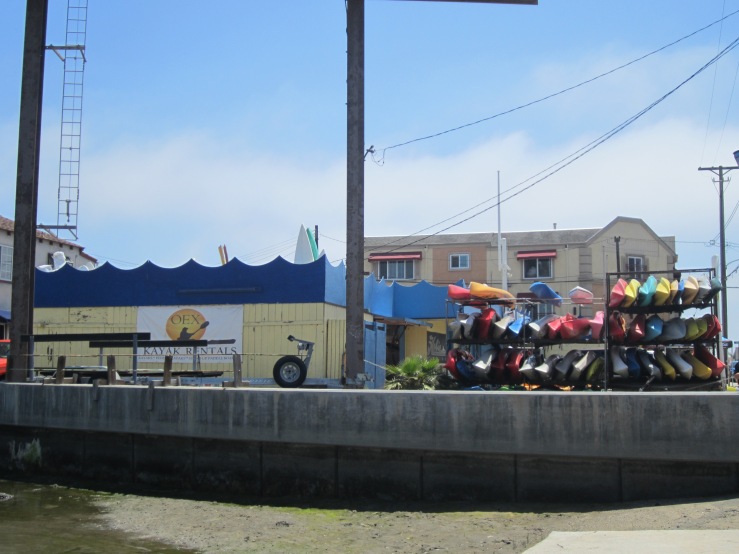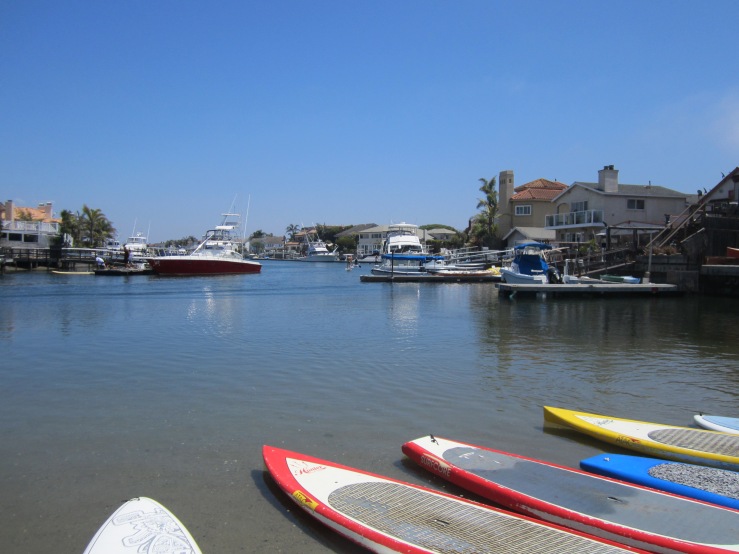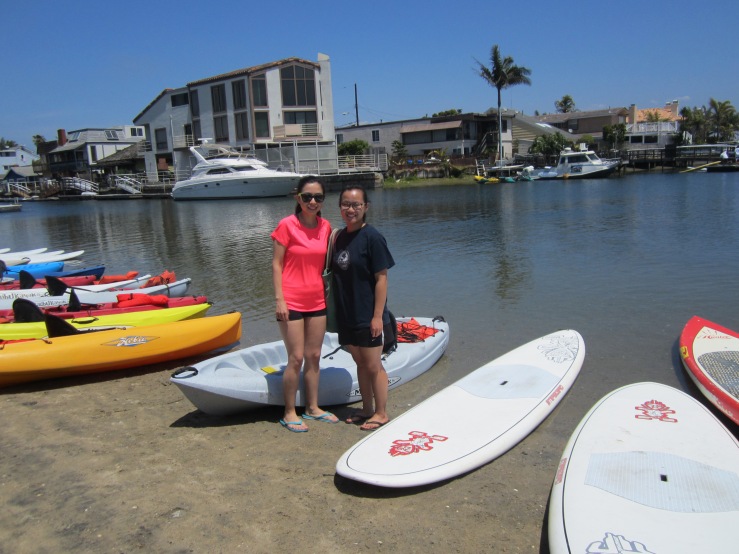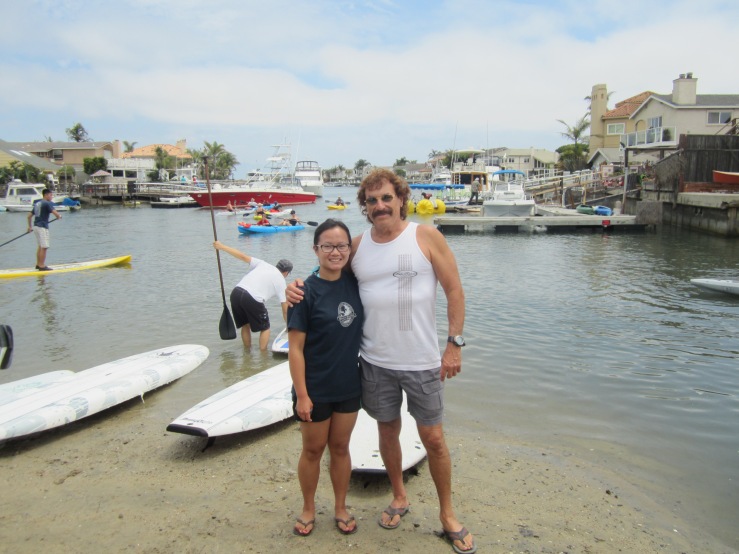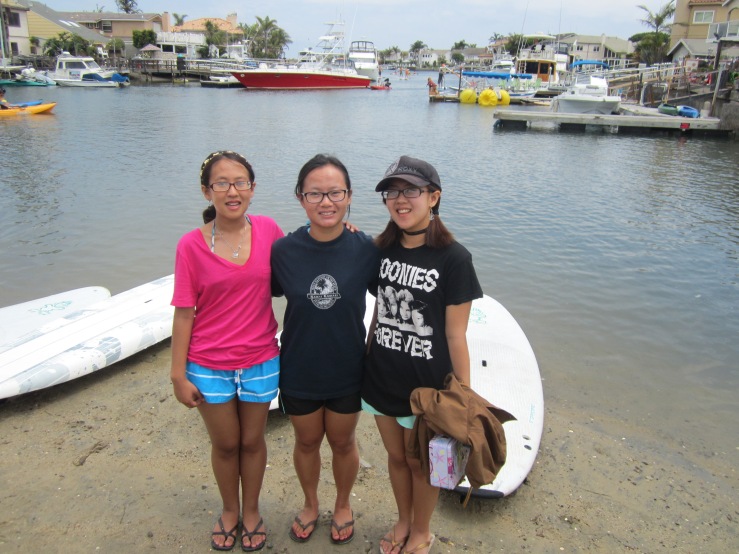A piece I wrote for my first literary journalism writing workshop. It is narrative nonfiction. Please feel free to share your thoughts!
Traffic roared by OEX Sunset Beach on a Saturday morning in May. Bright yellow paint adorned the shop, with blue trim designed to look like waves. Signs reading “sales & service” and “kayak & stand up paddle” hung on its exterior. A bright array of rental kayaks sat stacked to the side of the parking lot. Newbies and veterans of the water frequented the place. At Sunset Beach, kayaks and paddle boards rested on dark brown sand near the translucent blue water. The grayish skies were cloudless, the wind light.
At 10 AM, two girls standing by the kayaks at the beach awaited their first stand up paddle boarding lesson. With flip-flops kicked off, their toes touched the soft sand. The white Starboard paddle boards waited for them at the shoreline. The thought of mounting their boards made them nervous, but their instructor, Jerry Katz, didn’t give them much time to doubt. Jerry, 69, was 5’10”, muscular and tan. He stood apart from the crowd with his full head of wavy brown hair and a mustache to match. His searching eyes were the color of honey. Around his close friends you could see his face break into a wide smile. Retired now, he taught paddle boarding to his friends on weekends and let them stay out as long as they liked. He enjoyed watching them learn. Once they paid the shop to rent a board, he’d teach them for free. The convenience of renting right at the beach and choosing a new route each time made this place great. He had told one of the girls the other day that paddle boarding was easy in Huntington Harbor. She wouldn’t fall in the water on his watch—his students, with the exception of maybe two out of forty, stayed upright the entire lesson. Dressed in a gray tank top and shorts, he demonstrated to them the correct way to hold the black paddle, with one hand at the top and the other ten inches below. He waded into the water and gripped one of the boards. He gestured to both sides of the upper-middle part of the board.
You will move your board out into the water and sit with your knees on the board. If you feel like you are going to fall you can always go to your knees. It’s safe. Then you’ll want to slowly stand up on the board and unbend your knees until you can balance. Don’t stand up until you are moving forward in the water. The hand that is on top of the paddle will steer you into the direction you want to go.
Jerry intended to give the two coeds from UCI good instructions and a tour. Jerry watched Jennifer push-off into the water. Holding the paddle in her left hand and the board in her right, she climbed on the board and sat on her knees. The board shifted slightly but didn’t tip. Working the paddle into the water, she began to steer. He saw that she wished to stand, so he gave her the go-ahead. She slowly rose. Her friend Jazmin mounted her board as well. They hadn’t fallen in yet. Good. Both of them were exactly what he’d expected—they had never paddle boarded before, and their nervousness showed. His cousin Michael, who always accompanied him on his tours, cruised slowly up ahead on his board. Jerry watched as Jennifer practiced the paddling motion again.
You’re holding the paddle incorrectly, Jennifer. Hold it with the paddle going this way. She heeded his advice and gripped the paddle so that it faced the opposite direction, with the bottom shovel-like part coming towards her. She began gliding amidst the water using two long strokes, and in her excitement neglected to steer to the right with her left hand leading. Other hand on top. A pretty standard mistake, it happens. After awhile they’d get acquainted with the flow. Since a large white boat loomed closer, Jennifer steered away into the neck of the Huntington Harbor. Several styles of nautical equipment and white houses with leafy foliage sprouted from the docks. The girls’ nervousness started to wear off once they got the hang of it. After ten minutes away they went.
The one direction you don’t want to look is down. Your eyes will steer your board forward. You don’t want to go straight; your board will be moving a little to the left and a little to the right.
Jennifer maintained her long, rhythmic strokes in the water, alternating from left to right every three strokes as she passed by houses, docks and boats. The houses blocked her from the wind, serving as a measure of protection. Jennifer sought solitude as she paddled. Jerry didn’t mind; his students could do what they wanted. Just like he does.
Solitude finds Jerry when he is out hang gliding and surfing. To be Jerry is to respect nature. Nature is the earth, wind, sun, air we breathe, the animals down to the smallest insect. It’s all encompassing, the natural order of the world. Jerry finds meteorology so interesting that he’ll put you on hold to watch the weather report. You’ll never understand nature but you try to. You have to be in good shape to hang glide, because the higher you go, the more your oxygen intake decreases. You have to realize life is short and that it is your responsibility to get what you want out of it. You know what you want. The stakes are high if you are inexperienced, and naïve about where you fly. Sometimes even experienced fliers didn’t make it. He knew that well. He watched his good friend Buddy crash into a 1,500 ft mountain. Buddy broke his neck from the fall. He tried to get up and move around, but his spinal cord severed and he could no longer breathe. Since Jerry is experienced he doesn’t see the risk at all, just the potential for a future flight. His extreme confidence carries over to his independent thinking: learning and refining skills takes time and commitment. If he wants to surf, he can surf, and if he wants to hang glide, he can hang glide.
Today is a good day for flying here at Cerro Gordo Peak, Jerry thought on a Sunday morning in 1977 when he was 33. July 24 dawned with active and unstable conditions in the Inyo Mountains of California’s Owens Valley. Patchy, cumulous clouds filled the cerulean blue sky, with airflow coming out of the southeast bringing moisture from the Gulf of Mexico and California. Jerry’s chances to set a world record for the furthest distance in a hang glider looked promising. 100 miles wouldn’t kill him. He drove up the dirt road in Cerro Gordo, a silver mining town which means “Fat Mountain.” It featured one of the most productive silver mines in California, its ore hauled to the Los Angeles area. Sometimes Jerry would look for ore samples here. This morning, he went to see Barbara on the way to the peak. She lived in a notoriously drafty, 1,800 square ft, 120-year-old wooden house with a tin roof that gleamed when it caught the sunlight. A slender 5’3” woman in her late 60’s, with short, grayish hair, Barbara owned the property that would serve as his launch site. She always asked Jerry to sign her guest list. She’d give him water in return for his signature and make conversation with him.
At 1:30 PM Jerry tensed as he stood looking at fifty feet of cliff, which veered off abruptly into the abyss. He waited for the wind running south to north up the Owens Valley. Then, running with his glider, he leaped off the cliff, finding his first thermal—a column of warm rising air. To stay in the thermal he began flying in tight circles by shifting his body one direction to the other, steadily gaining altitude. The rapid beeps of his variometer affirmed his rate of climb. He had thermals on the brain because he needed height at this crucial stage. He could not rely alone on ridge lift from the wind that blew against the mountains. As he moved through the air, drag slowed him down. The faster he travelled the more drag he encountered, something he’d need to avoid. He understood the rough terrain and its tendency to create turbulence for a flier. Beginners might consider it hard to anticipate the weather conditions and act appropriately, as the unstable air off the peak meant wind blasted from different directions. But Jerry wasn’t a beginner. The wind whipped around him, his muscles relaxed and he concentrated on his next steps.
He caught several more thermals, climbing ever higher, and looked out at the magnificent landscape. The Inyo Mountains, 400 ft below him at times, beckoned and he’d descend just under the peaks. Other familiar landmarks included Mt. Whitney in the Sierra Nevada Mountain Range, also Owens Dry Lake and Lone Pine. As he gained altitude and distance he left the Inyos, moving towards the White Mountains, splotched with pockets of glistening snow along the uneven ridgeline and slope. A greenish tinge on the mountains intermixed with earth in various shades of chocolate, sepia and sandy brown. Sharp rocks jutted out in spurts, confirming that one mishap in midair could result in a fatal accident.
Jerry had flown Cerro Gordo many times before. The 7,800 ft peak served as a launch site for him and his fellow hang gliders. All of them had tried for months to be the first Class II glider pilot to soar cross country over a hundred miles. Pioneers like Jerry flew cross-country by starting at one point, thermalling up to14,000 ft and then continuing onwards. He called cross country a new concept for gliders who had gone through a rigorous trial and error process by the manufacturers to expand their capabilities. He had other records here, too: Friday’s maximum altitude of 20,000 ft and Saturday’s Altitude Gain of 11,482 ft from the lowest point of his flight to his highest point. Now he aimed for distance. He planned to take off from Cerro Gordo and fly just over 100 miles and come in for a landing at Janie’s Ranch in Nevada. With two years of experience, he trusted his knowledge and acquaintance with the area.
For Jerry, leaving the ground and soaring comes first. After that, cross-country is the goal—pushing the envelope. He will tell anyone it’s man’s dream, and you need nothing except a glider. You can hike your glider up a hill and just take off. Jerry’s investment in hang gliding comes from his idea that he is utilizing nature. He craves the feeling of flying because he is surrounded by nature. The camaraderie that naturally follows the sport is a big part of it, too. Hang gliding is part of life.
Jerry depended on his Pacific Gull Alpine competition glider. It was capable of a 10:1 glide ratio, which meant that from one mile up he could travel ten miles forward. The 16 ft. long wing had a patch of cornflower blue in its center, followed by patches of white and navy blue wingtips. A triangular structure called the control frame hung suspended through the middle portion of the wing. To control the glider, Jerry shifted his weight in the direction of the intended turn and used the shift control bar to move backwards or forwards. His glider came equipped with a harness and a white parachute, which he wouldn’t need to deploy unless he had to make an emergency landing. He had never used a parachute in his life, but he carried one out of safety. For protective gear, he wore a medium-red colored powder suit to combat the freezing temperatures beyond 15,000 ft, special sunglasses to prevent glare, ski gloves and a black helmet. Instruments attached to the glider included an altimeter that would measure his approximate height and air pressure, a citizen band two-way radio and a sealed barograph to record his altitude and times on a chart from takeoff to landing. He obeyed the regulations for a glider pilot interested in setting records.
After Jerry bought a kit and put a glider together in 1973, he took a single hang gliding lesson from Bill Bennett Hang Gliders on the beach at Playa Del Ray. He had talked to Bill Bennett and Bill Moyes, men who helped popularize the sport by adapting NASA engineer Francis Rogallo’s Wing into manufactured flexible wing gliders. Like many other beginners, Jerry the first time made it 15 ft off the ground and flew for 100 ft. Escape Country, near El Toro, became his flight territory. He practiced on 500 ft hills and advanced to the 1,300 ft hills once he felt comfortable. He moved onto flying off mountains after he had mastered Escape Country.
At 10, 12 and up to 14,000 ft, Jerry discovered stronger cloud development. This related to the thermals rising. The clouds cast an ominous dark blue and purple hue on the land below, as they crept ever closer to Jerry’s glider. He called it “overdevelopment”, the perfect condition for a thunderstorm. This thunderstorm developed by updraft, the same as thermals, and overdevelopment arrived from the south due to monsoon flow. Fifty miles in, Jerry flew over Black Mountain Peak, and then crossed the White Mountains. Westgard Pass, a crucial point of his flight, lead out of Big Pine. The battle against the wind wasn’t terrible because there were no westerlies that day, so his passing over it left him a 50/50 chance to fly further.
What is this airflow going to do? Will I find lift? Am I going to hit some thermals? What are the clouds and conditions like? Where are the people I started the flight with?
At 16,000 ft the pilot of a white sailplane running parallel to Jerry, a bit below him, warned him of a thunderstorm building up behind him. The pilot dipped a wing in the air to him, and pointed back to the gathering clouds. Jerry acknowledged him with a thumbs up. For half the flight Jerry had been scratch-flying, trying to work his way up higher in light lift. He pressed on, though, getting to use his skills. As lightning flashed far in the distance while thermalling, a pair of golden eagles helped him get through the last stretch of the flight. He passed the 95 percent mark as he crossed the state line to Nevada.
The thunderstorms brewed in the distance as Janie’s Ranch came into view. A rush of adrenaline kicked in. His world record stared him in the face. The timing—perfect. Jerry didn’t worry about setting this record or not, just thought of it as an incredible opportunity. While at a steady 18,000 ft, with the ability to continue fifty miles more, he didn’t want to push it. Better to work his way down before he got sucked up into the storm. He spotted a landing field with an orange wind sock on a dirt strip and started doing aerobatics, which caused him to lose altitude quickly. 7,000 ft to go…6,000…5,000…4,000… 3,000…2,000…1,000… The ground rushed closer to him, Janie’s Ranch getting larger, the wind whipping his hair. He turned into the headwind and pushed the control bar in, tipping the glider nose upward to slow his progress. He went straight down, like a parachute. He sought control without blowing backward in the wind. His glider stalled, allowing him to land correctly on his feet. An all-around easy landing, thanks to the gusts of wind. Four and a half hours in the air—so worth it. The 103-mile world record…was his.
It had been a stellar day to get lucky and he felt elated that he made it without crashing. A stoked Jerry felt even more excited about going home. No time to sit and contemplate his record here. He had work tomorrow, after all. A road wound its way back to Lone Pine, a hundred miles away. To get there, he’d need to hitch.
He dubbed Janie’s Ranch, an off-white, five bedroom house a “gentleman’s club with benefits.” Janie herself wondered why he landed in front of her property and would he partake from them? He deflected the question by telling them he had a glider to get home and that it wasn’t interested. Then, a chubby, bald man smelling of alcohol sporting glasses and gray side burns offered him a ride back to Lone Pine, the hang gliding base. Jerry didn’t think twice. He folded up his glider, setting it in the back of his ride’s dump truck. He didn’t mind that his new road buddy enjoyed drinking a half gallon of Red Mountain wine while he drove. From Nevada they went through Bishop, Big Pine and Independence in just over two hours. Proud and tired, the world record holder welcomed the return to civilization, happy to rest his sore legs for a bit.
Jerry didn’t make a big deal out of getting the record, not realizing so many people thought differently. He got asked to interview for articles and go on television and he rejected most of the offers because popularity didn’t interest him. Rather, spending weekends with friends doing a sport he genuinely liked motivated him. He appreciated the physiological aspect involving endorphins and rising serotonin levels and felt the same thing after surfing a great wave, and skiing a challenging mountain.
Three hang gliding manufacturers wanted him to fly their gliders. He tested their gliders and got a little money, but not much. People in the small hang gliding community shook his hand and knew his name. He also ended up in the Guinness Book of World Records. It took five years for someone to break his record.
He remained the same old Jerry, though not quite as driven. The Chuck Yaeger of hang gliding had lowered his intensity level from 100% to 75%. He continued to fly cross country and competed in numerous competitions, but then transitioned into recreational hang gliding.
Jerry went into private business selling building material, divorced, raised a son and taught hang gliding. At age 69, he’s still learning. He volunteers at the LA County Arboretum and does crime analysis for the LA County Sheriff’s Department. He’ll tell you about teaching third and fourth graders from different schools around the county about the different plants and other wildlife surrounding them. Pointing out lakes and waterfalls to kids who have never laid eyes on them before makes him appreciate nature all the more.
He favors free form landscaping, which is apparent when you visit him and see his garden. This spectacular 20-year-old garden is a certified wildlife habitat: it lays claim to over 375 species of plants and 50 different trees. Real order does not exist. You catch what you miss the first time, as if the magic of the place swallows you whole. Among the kumquats, loquats, sweet lemons, pomelos, cherimoyas and Hawaiian plants, to name a few, nestle Buddhas and lawn ornaments. Jerry feels tranquil here, and when he waters he sees what is changing in nature.
36 years after setting the hang gliding world record, he’s lining up things to do in his busy schedule: biking, surfing, teaching stand up paddle boarding, watching lectures from The Great Courses, visiting with his family and trying to meet women. He still hang glides, though he doesn’t feel like he has to fly all the time.
In Huntington Harbor, Jerry stayed back with Jazmin, who paddled slower. The pair talked about family and rested once in awhile, taking it easy. Jennifer kept paddling faster and faster, her rhythm mechanical and fluid. She propelled herself forward by raising her arms and pushing through the down stroke as if she were slicing the water with great force. She should be going faster since she felt comfortable and Jerry’s cousin Michael kept her company. Get your butt back to the side and don’t get hurt, he thought as he observed Jennifer’s tendency to edge into the middle of the channel. He wanted her to mind the boats and yachts coming through the center and to stay out of their way. Keep to the right side where the boats are. If there aren’t any boats coming, you’re fine.
As Jennifer passed by Gilbert Island, Jerry and Jazmin caught up to her. Jerry pointed. To your left is Trinidad Island. You two are doing very well. At this point they could loop around Trinidad Island and return to Sunset Beach, but they asked to continue. The strength of the learner mattered to Jerry, and he felt the girls still had enough energy. Most people he taught felt they had had a sufficient tour at this point and turned back.
That boat there is a Duffy. A small, electric-powered boat with navy blue trim hanging from its top moved towards them on the other side of the harbor. They caught the boat’s wake with their boards pointed straight into the waves. Jennifer stopped paddling for a moment to judge how stable she was. After taking on the first wake, the girls anticipated and enjoyed the small waves from boats that came their way. They managed well because they were taught to point straight and not perpendicular into the wave. The group passed large groups of kayakers and paddle boarders. They called to each other every time they peered down into the 20 ft deep water and saw golden brown shore stingrays darting beneath them, creatures Jerry usually didn’t encounter when he paddle boarded here. Little white birds hunted fish. A Styrofoam 7-Eleven coffee cup floated in the water.
They took a right and continued down the channel until they saw the Pacific Coast Highway and a large bridge. If they floated beyond the bridge they could get fined for being in a no-paddle zone. Jerry told them to paddle around the orange and green shoal markers a hundred feet ahead, cut across the wide channel and stick to the right side where the boats were. Here the current picked up into what he called a two-for-one, meaning that every two strokes equaled the effectiveness of one back in calmer waters. You are exercising your core muscles now. And see that thing up there in the air? What’s that? How cool is that? A paraglider, Jennifer answered, seeing the orange and red parachute in the sky. Yes, that’s right. Wish it was me, Jerry thought. Jennifer sped up after hearing Jerry’s instructions, determined to cross the channel before the two approaching boats came closer. Jerry helped Jazmin learn how to paddle a certain way—she had to turn the steering mechanism and her board into the headwind, paddling harder in the strong crosswind of the channel. She wasn’t using enough energy. Floating near a green bank, he watched her struggle against the wind and then gave her instructions to correct the problems. Jerry yelled at Jennifer and Michael to wait up when he was within earshot.
Passing Broadmoor, they took a right away from the main channel and went through some canals. Then they cruised by Admiralty Island in a narrow section of the harbor. They saw cars going by in the residential area away from the harbor on their left. Off to the right was a long row of waterfront property. No two houses were alike. Jerry liked paddling at a slow pace; he exercised often and felt no fatigue. The girls’ energy levels dropped, something entirely normal. The energy they generated came through their arms and into the core of their bodies, easing down into their heels. Their heels pushed the boards forward, keeping them stable.
In the final stretch back to Sunset Beach the girls gained more confidence than ever as they steered through the water. Jerry led the group towards the rainbow of kayaks. Go in straight to the shore, real slow. As the board hits sand, step off to the side. To prevent herself from crashing into Michael when they reached the shoreline, Jennifer risked bumping the nose of her paddleboard into an orange kayak and almost tumbled in. She did the quick motion stop and propelled forward, what he wanted her to avoid. With the exception of her recent lapse, Jennifer did better on the paddle board than Jazmin. Some people remain stiff when they paddled, but not her. Jazmin quickly figured out how to do it after more instruction. Jerry encouraged her to dismount her board slowly, and she made it without any problems.
Jerry smiled when the girls told him how much fun they’d had out on the water—they had done something they didn’t think they could do at first. They had such a good time, and it made him happy. He wanted them to take another lesson soon. As the girls said goodbye to Jerry, the sun rose high in the brilliant blue sky. Other people were preparing to paddle board away from Sunset Beach. It was 11:45 AM, time for Jerry’s 15-mile bike ride. But he hoped the girls would find a way to get back on those boards.


